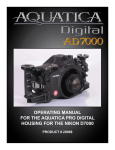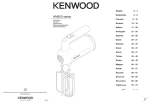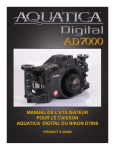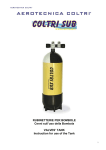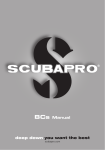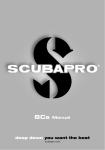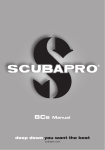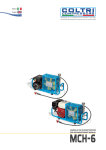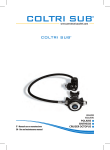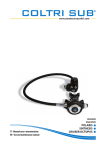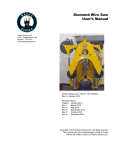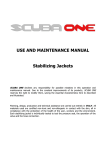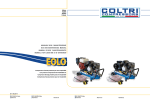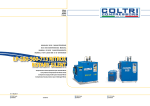Download manual - Aerotecnica Coltri S.r.l.
Transcript
EQUILIBRATORI BCD’S MANUALE USO E MANUTENZIONE OPERATIONS EQUILIBRATORI - BUOYANCY JACKETS OJ 1.0 - OJ 2.0 - TYKE OJ 1.0 SACCO/BLADDER MONOSACCO/SINGLE BLADDER SACCO ESTERNO/OUTSIDE BLADDER CORDURA® 1000 D CORDURA® 1000 D NYLON HT 420 D SACCO INTERNO/INSIDE BLADDER NYLON HT 420 D NYLON HT 420 D NYLON HT 420 D VALVOLA SOVRAPPRESSIONE/OVER PRESSURE VALVE 2 1 1 VALVOLA SCARICO RAPIDO/ RAPID DUMPING VALVE 3 32 FINO/UP TO 5 KgFINO/UP TO 2 Kg - SCHIENALINO/BACKPACK SI’/YES SI’/YES Si consiglia l’uso dell’equilibratore dopo aver frequentato un corso di immersione presso un centro di addestramento subacqueo, abilitato al rilascio di brevetti. Questo dispositivo non è un giubbetto di salvataggio e non garantisce il mantenimento della testa fuori dall’acqua. I jacket, oggetto delle presenti istruzioni per l’uso, sono stati certificati per una profondità massima di immersione di 50 metri. Q Massima pressione di utilizzo 10 Bar Q Minima pressione di utilizzo 7 Bar ISTRUZIONI PER USO E MANUTENZIONE La funzione principale del jacket è di agevolare l’immersione mantenendo il subacqueo in assetto neutro a qualsiasi profondità. FISSAGGIO DELLA BOMBOLA Prima di indossare il jacket è necessario bloccarlo saldamente alle bombole mediante le apposite cinghie, Figura A, la cinghia principale deve essere assemblata come Figura B. AVVERTENZA: prima di serrare la cinghia principale è opportuno bagnarla per evitare allungamenti del nastro. ATTENZIONE: nel caso si dovesse applicare il jacket ad un gruppo bibombola, è necessario contattare il fabbricante o un rivenditore autorizzato per ulteriori informazioni (1) Figura C, kit Bibo. ELENCO CONTROLLI PRELIMINARI Q Verificare il serraggio delle ghiere delle valvole. Q Assicurarsi del buon fissaggio tra bombola e schienalino. Q Controllare il funzionamento delle valvole di sovrappressione/scarico rapido. QControllare il sistema di carico orale Figura D. Q Assicurarsi che la frusta sia collegata ad un’uscita di bassa pressione del primo stadio dell’erogatore. Q Verificare l’aggancio della frusta con il gruppo comando Figura F. Q Provare ripetutamente le funzioni del gruppo comando Figura E-F-G. Q Gonfiare completamente il jacket sino all’entrata in funzione delle valvole di sovrappressione, quindi attendere 15 minuti circa, se il jacket si sgonfiasse evitare l’uso e rivolgersi ad un centro assistenza autorizzato per il controllo. Q Evitare l’esposizione diretta ai raggi solari ed il contatto con superfici ruvide o taglienti. COME INDOSSARE IL JACKET INFLATOR BASIC PER/FOR OJ 1.0 INFLATOR F2 PER/FOR OJ 2.0 E/AND TYKE VALVOLA SOVRAPPRESSIONE OVERPRESSURE VALVE AEROTECNICA COLTRI® S.p.A. via dei Colli Storici 177 25010 San Martino della Battaglia Brescia - ITALY Tel: +39.030.99.103.01 +39.030.99.102.97 Fax: +39.030.99.10.283 [email protected] www.aerotecnicacoltri.it TYKE TASCA PORTA ZAVORRA/WEIGHT POCKET ATTENZIONE ELENCO PARTI COMPONENTI GLI EQUILIBRATORI LIST OF PARTS OF BUOYANCY JACKETS OJ 2.0 Q Allargare i nastri degli spallacci alzando i puntali delle fibbie Figura H. Q Indossare il jacket inserendo un braccio dopo l’altro dentro gli spallacci. Q Chiudere il fascione ventrale con velcro (1) Figura H. Q Serrare gli spallacci agendo con i pollici dentro gli anelli a “D” Figura H. Q Agganciare la fibbia ventrale scorrevole e serrarla al massimo (2) Figura H. Q Agganciare la fibbia sternale scorrevole e serrarla al massimo agendo su entrambi i nastri (3) Figura H. FUNZIONAMENTO Q In superficie: gonfiare completamente il jacket, per ottenere una spinta positiva sino al galleggiamento senza aul’ausilio delle pinne Q In immersione: sgonfiare il jacket utilizzando uno dei seguenti metodi: A) Premendo il pulsante di scarico del gruppo comando tenendo il corrugato verso l’alto oltre l’altezza delle spalle, Figura E. SI’/YES B) Agendo sulla valvola di scarico rapido, posta sulla spalla destra, tirando il cordino alla cui estremità è posta una pallina C) Tirando il gruppo comando verso il basso, Figura G. Q Assetto neutro: raggiunta la quota prefissata si ottiene un equilibrio neutro immettendo aria nel jacket, nella giusta dose, tramite il pulsante di scarico, Figura F. L’operazione deve avvenire in modo graduale per evitare scompensi dovuti al ritardo della risposta di variazione dell’assetto. Q Risalita: staccandosi dal fondo o comunque lasciando la quota massima raggiunta per iniziare la risalita, sempre utilizzando la spinta delle pinne per controllare la velocità di risalita e non utilizzando il jacket come sistema ascensionale, agire con i sistemi di scarico sopra descritti per contrastare l’espansione dell’aria e il conseguente aumento di spinat positiva. Raggiunta la superficie rifarsi al paragrafo inerente. ATTENZIONE: Durante la risalita è necessario regolare l’equilibrio idrostatico al fine di evitare una velocità di risalita troppo elevata. Consultate il vostro istruttore o il manuale di immersione per adottare la velocità di risalita adeguata. Evitare di utilizzare il jacket come sistema di sollevamento di oggetti dal fondo, in quanto la perdita della presa sull’oggetto può causare un aumento repentino della velocità di risalita. VALVOLA DI SOVRAPPRESSIONE: SCARICO RAPIDO Il jacket è dotato di valvole sovrappressione/sacrico rapido. La valvola entra in funzione quando la pressione interna al sacco supera la pressione esterna di un valore prefissato dalla taratura della molla. Questa valvola ha la funzione di prevenire il danneggiamento del jacket causato da una pressione interna eccessiva. La valvola funziona come scarico rapido tirando la pallina posta all’estremità del cordino. La valvola è posizionata sulla spalla destra, Figura A, e posteriormente in basso a destra, Figura R, per facilitare lo scarico in posizione capovolta. TASCHE Le tasche sono del tipo a soffietto per aumentare la capienza. La chiusura a velcro assicura una perfetta tenuta. SISTEMA PORTAFRUSTE Il jacket è provvisto di un sistema portafruste con chiusura a velcro di tipo a sgancio rapido per l’erogatore di emergenza e di tipo avvolgente per la strumentazione, FIGURA I, per fissare eventuali parti sospese dello scuba (octopus, manometro, ecc) vi è la possibilità di utilizzare dei moschettoni portafruste. MANUTENZIONE ORDINARIA Q Evitare l’esposizione prolungata ai raggi solari Q Non introdurre oggetti appuntiti nelle tasche Q Evitare lo stivaggio per lunghi periodi del jacket umido e/o piegato Q Riporlo parzialmente gonfio in luogo fresco, asciutto e buio. Q Dopo ogni immersione in mare o piscina, sciacquare in acqua dolce sia internamente che esternamente. Per sciacquare internamente il jacket seguire la procedura: Q Riempire il jacket per circa 1/3 della capacità, con acqua dolce, tramite il boccaglio del gruppo comando premendo il pulsante di scarico, FIGURA E. Q Gonfiare il jacket a bocca, Figura D, e agitarlo energicamente. Q Capovolgere il jacket e scaricare l’acqua attraverso il pulsante di scarico del gruppo comando (lo stesso utilizzato per il riempimento). Q Lavare con cura le valvole di sovrappressione e il gruppo comando. ATTENZIONE Non impiegare solventi o altri prodotti chimici per la pulizia. Le riparazioni e i controlli sono da eseguire sempre presso dei punti di assistenza autorizzati Aerotecnica Coltri S.p.A.. Aerotecnica Coltri S.p.A. declina ogni responsabilità per danni arrecati a persone o cose a causa di manomissioni e/o interventi non effettuati da Aerotecnica Coltri S.p.A. o da centri di assistenza autorizzati. I D.P.I. oggetto del presente manuale d’istruzione sono stati sottoposti alle prove di tipo in accordo alla norma EN250 (III categoria direttiva 89/686/CEE) a cura di ITALCERT - viale Sarca 336 Milano Organismo notificato n° 0426. WARNING: Use the buoancy jacket only after attending a diving course at a diving training centre that is authorised to issue certificates. This device is not a life jacket bacause it does not guarantee that the head will be kept out of the water. The jackets that are the subject of this manual have been certified for use down to a maximum depht of 50 metres. Q Maximum operation pressure 10 Bar Q Minimum operation pressure 7 Bar USE AND MAINTENANCE INSTRUCTION The main purpose of the buoyancy jacket is to facilitate diving by maintaining the diver in a neutral position at any depht. FIXING TO BOTTLES Before donning the jacket it must be firmly fixed to the bottles by means of thestraps indicated by the arrows in Figure A. The main strap must be assembled in the manner shown in Figure B. WARNING: If the jacket is to be fixed to a twin-cylinder set, contact the manufacturer or an authorised dealer for further information (1) in Figure C. PRELIMINARY CHECKS Q Check that the ringnuts on the valves are tight. Q Make sure that the cylinder and the backpack are firmly fixed together. Q Check that the rapid exhaust dump/over-pressure valve is working properly. Q Check the oral inflator, Figure D. Q Make sure that the hose is connected to a low-pressure outlet port of the regulator’s first-stage. Q Check that the hose is connected to the control unit, Figure F. Q Test the operating efficiency of the control unit several times, Figure E-F-G. Q Inflate the jacket completely until the over-pressure valves are triggered. Then wait about 15 minutes. If the jacket deflates during this time, do not use it and contact an authorised customer-service centre for a check. To not expose the jacket to direct sunlight or let it come into contact with rough or sharp surface. HOW TO PUT ON THE JACKET Q Loosen the shoulder straps by lifting up the points of the buckles, Figure H. Q Put on the jacket by putting one arm after another through the shoulder straps. Q Close the waistband with the Velcro strip, Figure H. Q Tighten the shoulder straps by using your thumbs to pull on rings (D), Figure H. Q Pull the sliding waistband buckle to tighten as fully as possible by pulling on both belts, Figure H. OPERATION Q On the surface: inflate the jacket completely to orbtain a positive thrust so that you can float without using the fins. Q When diving: deflate the jacket by using one of the following methods: A) By pressing the dump button of the control unit holding up the corrugated hose about the shoulders, Figure E. B) Adjusting the rapid exhaust dump valve on the right shoulder. C) Pulling the cord that has a ball at the hand. D) Pulling down the control unit, Figure G. Q Neutral position: when you have reached your required depht, you can obtain a neutral equilibrium by pressing the inflation button to inflate the jacket by the correct amount, Figure F. The jacket must be inflated gradually to avoid imbalance due to the delay in responding to variations in inflation. Q Returning to the surface: when leaving the bottom or starting to return to the surface, use the fins to control the speed of ascent and do not use the jacket as an ascent system. Use the exhaust dump systems described above to counteract the air expansion and therefore the increase in positive thrust. For the procedure on the surface, see the relevant paragraph. Fig. A Fig. B Fig. C Fig. D Fig. E Fig. F Fig. F Fig. G Fig. I Fig. R Fig. H WARNING: Buoyancy must be controlled during the ascent to prevent too rapid decompression. Consult your instructor and the diving manual to find out the correct ascent speed. Do not use the jacket as a system for lifting objects of the seabed because if you drop the object your ascent speed might suddenly increase. OVER-PRESSURE/RAPID EXHAUST DUMP VALVE The jacket has over-pressure/rapid exhaust dump valves. The valve is triggered when the pressure inside the bladder exceed external pressure by an amount that is pre-set by the spring. This valve prevents the jacket from being damaged by excessive internal pressure. The valve works as a rapid exhaust dump valve if the ball at the end of the cord is removed. In all models, the valve is located on the right shoulder, Figure A, there is another over-pressure/rapid exhaust dump valve at the back in the right-hand corner, Figure R, to facilitate dumping when the diver is descending headfirst. POCKETS The pockets have a concertina design to increase their storage capacity. The Velcro closure ensures a perfect seal. HOSE-HOLDING SYSTEM The jacket has a hose-holding system with quick-release Velcro closure for the emergency regulator and a wrap-around system for the instruments, Figure 1, any suspended parts of the diving equipment (octopus, gauge) hose snap rings can be used. ROUTINE MAINTENANCE Q Do not exposure to sunlight for prolungate periods. Q Do not place sharp objects in the pockets. Q Do not store the jackets wet or folder for long periods. Q Inflate it partially before storing it in a cool, dry and dark place. Q After each sea or pool dive rinse both inside and outside in fresh water. To rinse the jacket inside, follow this procedure: Q Fill the jacket by about 1/3 with fresh water by means of the mouthpiece by pressing the dump switch, Figure E. Q Inflate the jacket orally, Figure D, and shake it energetically. Q Turn the jacket upside down and release the water through the dump switch of the control unit (use the same switch for filling). Q Wash the over-pressure valves and the control unit thoroughly. WARNING: Do not use solvents or other chemical product for cleaning. Repairs and checks must always be carried out by authorised Aerotecnica Coltri S.r.l. customer service centres. Aerotecnica Coltri S.p.A. declines all liability for personal injury or damage causated by tampering and/or interventions not carried out by Aerotecnica Coltri S.p.A. or by authorised customer service centres. The personal protective equipment described in the user manual has been subjected to the tests specified in EN250 category III of Directive 89/686/EEC) and EN1809 (category II of Directive 89/686/EEC) administered by ITALCERT viale Sarca 336 Milan registration number 0426. ELENCO PARTI COMPONENTI GLI EQUILIBRATORI LIST OF PARTS OF BUOYANCY JACKETS 1 - Sacca in Cordura 1000 D per OJ 1.0, OJ 2.0, Nylon 420 D per TYKE Outer bladder in Cordura 1000 D for OJ 1.0, OJ 2.0, Nylon 420 D for TYKE 2 - Schienalino rigido / Stiff backpack 3 - Corpo superiore tubo comando / Top outlet body control 4 - Frusta di bassa pressione con innesto rapido / Rapid-action low-pressure hose 5 - Comando carico aria / Air inflation control 6 - Fibbia a sgancio rapido / Quick-release buckle 7 - Pallina scarico rapido / Ball of rapid exhaust dump valve 8 - Spallina passafruste con Velcro / Hose loop with Velcro 9 - Valvola di sovrappressione / Over-pressure valve 10 -Fascione ventrale con regolazione Velcro / Waistband with Velcro adjustment 11 - Fibbia sternale / Chest belt 12 - Fibbia ventrale / Waistband belt 13 - Tasca a soffietto / Nylon pocket 14 - Sistema di fissaggio di sicurezza alla rubinetteria / Safety fixing system 15 - Controschienalino / Cylinder support pad 16 - Fascia fissaggio bombola con fibbia / Cylinder camband with buckle 17 - Valvola di sovrappressione posteriore / Rear over-pressure valve 18 - Pomello di estrazione rapida tasca per zavorra Knob of rapid-extraction pocket for weights 19 - Tasca per zavorra / Weights pocket La marcatura di conformità significa il rispetto dei requisiti Norme europee di riferimento. essenziali di salute e sicurezza di cui l’allegato II D.e. 89/686/CEE. European reference standards. The CE conformity marking indicates that the essential healt and safety requirements specified in the annex to European Directive 89/686/ Dimensioni massime e EEC have been met. minime delle bombole Fabbricante / Manufacturer utilizzabili espresse in litri e Numero dell’organismo in millimetri. notificato. / Number of Maximum and minimum certification body. dimensions of cylinders used expressed in litres and millimetres Anno di fabbricazione. Year of manufacture. Riferimento al modello e alla spinta massima di galleggiamento espressa in Newton. Il riferimento alla MODELLI: Attenzione: taglia è cucito sull’etichetta il riferimento al modello all’interno del corpetto. acquistato è ricamato Reference to model and to sulla parte anteriore del maximum buoyancy thrust modello. expressed in Newtons. The MODELS: N.B.: the reference to the jacket size reference to the model is sewn onto a label inside purchased is sewn onto the jacket. the front of the buoyancy jacket. 3 4 7 6 2 5 1 17 9 8 13 18 12 10 19 11 14 15 16 OJ 1.0 3 8 9 4 14 1 15 17 2 13 19 18 11 7 5 6 10 12 OJ 2.0 8 3 4 11 15 5 9 2 1 6 7 14 16 10 12 13 Avvertenza / Warning 17 TYKE


